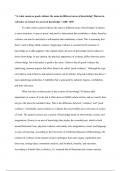“ Is what counts as good evidence the same in different areas of knowledge? Discuss in
reference to at least two areas of knowledge.” 1600- 1450
To what extent is good evidence the same in different areas of knowledge? Evidence,
in most situations, is seen as proof, and proof is information that establishes a claim, therefore
evidence can also be described as information that establishes a claim. This is assuming that
there’s such a thing called evidence. Supposing evidence is essential in the creation of
knowledge as it adds support to the original claim, all areas of knowledge need evidence to
derive knowledge. In my opinion, the physical appearance of evidence differs between areas
of knowledge, but what makes it good is the same. I believe that all good evidence has
underlying common aspects that allow them to be called “good evidence”. Although the type
of evidence used in history and natural sciences can be distinct, all good evidence has these 3
main underlying similarities. Credibility that’s generated by authority figures, verifiability,
and time relevance.
What role does evidence play in the creation of knowledge? Evidence adds
importance to a piece of work, but it often does not fulfill certain criteria, and as a result, does
not give the piece the intended value. This is the difference between “evidence” and “good
evidence”. Essentially, good evidence is evidence that successfully gives relevance to a piece
of work. The natural sciences are a system of knowledge based on observations, reason, and
imagination. History is an area of knowledge that studies the recorded past, which is built
around historians' bias, physical evidence, and mainly uses imagination, reason, and language
as ways of knowing. According to the University of California Museum of Paleontology, the
creation of evidence in the natural sciences undergoes four main stages, exploration and
discovery, testing ideas, community analysis, and feedback, benefits, and outcomes.
According to Charles Hou, in history, it’s assumed that all historians have biases and are
, aware of it. Whilst the creation of evidence is different in the two areas of knowledge, the
way knowledge is created between them is identical. I believe that the creation of knowledge
in most areas of knowledge relies on reason, imagination, and language as they are methods
by which knowledge is explored and as a result created. Evidence comes into play afterward
as it allows the claim to either be supported or contradicted. The types of evidence used in
history are physical remains, oral reports, visual documents, and written documents, which
are qualitative evidence and in natural sciences, evidence tends to be reports, experiments,
and observations, which is quantitative evidence. History is mainly propositional knowledge
whereas natural sciences can have propositional but also procedural knowledge.
Although good evidence can be different between the areas of knowledge, in my
opinion, the criteria that make it good evidence are the same throughout. One aspect that all
good evidence has is credibility. Credibility is the value given to something that makes it
believable, which can be achieved by an authority figure. To what extent do authority figures
add credibility to an area of knowledge? An authority figure is someone that withholds
knowledge, and a position of power which allows them to be seen as a superior figure in their
area of knowledge. Some examples of authority figures are Nobel prize winners, well-known
researchers, professors. Authority figures in natural sciences tend to be scientists, such as
Stephen Hawking and Alain Aspect, and in history, historians like Eric Hobsbawm,
Christopher Hill. To add value to a work, multiple people collaborate on it and copublish it,
and for that, there are two main objectives: to add credibility to the published work and to
share ideas and different points of view to minimize any potential biases. A recent example of
the usage of co-authorships in the natural sciences is the recent physics paper published by a
total of 5154 authors which was about the most precise estimate of the mass of the Higgs
boson, known. Since this paper was signed by many authority figures, it added credibility to




